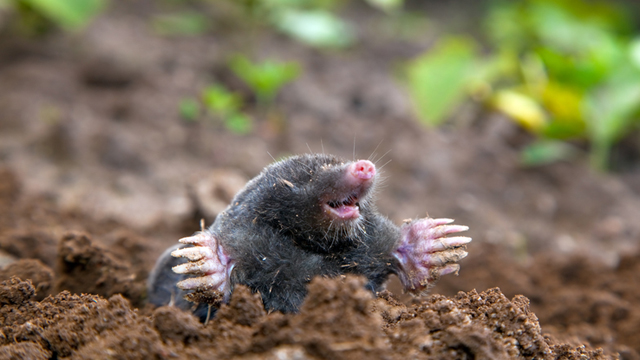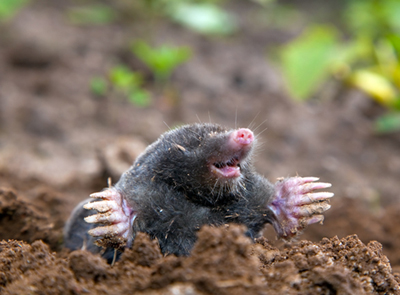Saluting the mole
The mole is an engineering genius, the Brunel of the animal kingdom, and extraordinarily industrious, if not always appreciated. David Profumo delves into its shadowy life


There is something quietly valiant about our common mole. It pursues a solitary, pioneering lifestyle and is prodigiously strong (the collective noun is a labour), yet most talpine literature- from Aristotle to the present day-is devoted to its destruction. It is familiar, yet practically invisible; few of us have actually seen one alive.
Surprisingly small (W. H. Hudson described it as ‘no bigger than a lady's gloved hand'), the mole's thickset, cylindrical body is superbly adapted to its subterranean existence. The distinctive fossorial forelimbs, which sport a sixth, unjointed ‘digit', bespeak a life of excavation, and it is reckoned Talpa europaea can shovel 10lb of soil in 20 minutes-the human equivalent of a miner shifting 12 tons an hour, by hand. The miniscule eyes are not blind, although the mole has become a byword for shortsightedness; it patrols largely in response to vibrations, assisted by the whiskers surrounding its sensitive, elongated snout.
It appears to have no neck, but, in fact, possesses seven cervical vertebrae, the same number as a giraffe. They have sharp teeth and, during the spring breeding season, the males (boars) happily eviscerate any rivals. In D. H. Lawrence's graphic story Second Best, two girls toy with one and ‘suddenly the mouth turned like a spark on her finger'. The fur is generally dark grey, but colour variants range from apricot to albino. The short fur has no nap, facilitating easy manoeuvres in tunnels (moles are reputed to trundle as fast as a trotting horse); the winter pelts (clears) were once sought after for making hats and breeches.

* Subscribe to Country Life and save; Get the Ipad edition
Originally a woodland creature, its signs are most evident in grassland, where its abundance is seldom appreciated. Moles enjoy a gargantuan appetite, sometimes consuming their body weight in food each day. Their insectivore diet includes beetles and slugs, but will run to mice and small birds. Earthworms are top of the mole menu. In times of plenty, buried ‘larders' are stocked with decapitated worms paralysed by the mole's toxic saliva.
Its Old English name of mouldwarp signified a ‘thrower of soil' and the Norse appellation want (for ‘turning') persisted for centuries in the term ‘want-hills'. These tumps of earth are blights on gardens, golf courses and even battlefields-their extirpation from the site of Culloden was recently waived only because of the ancient esteem among Jacobites for the ‘little gentleman in black velvet', whose mining operations caused William of Orange to tumble from his horse. Agricultural havoc is regularly caused to drainage, pasture, and stored silage-one field survey recorded 7,380 hillocks per hectare (two-and-a-half acres), so farmers aren't making a mountain out of nothing.
The history of husbandry bristles with talpicide. Stabbing, flooding, gassing and poisoning, using smoke bombs, Juicy Fruit gum, sump oil, windmills, cat litter, broken glass and spurge (Euphorbia lathyris) has still failed to discover a panacea. The Romans tried to drown them in clay pots (moles are good swimmers) and hazel snares were once popular.
Sign up for the Country Life Newsletter
Exquisite houses, the beauty of Nature, and how to get the most from your life, straight to your inbox.
Although they aren't nocturnal, moles are traditionally associated with those who work in darkness-Hamlet refers to his father's ghost as ‘old mole', as the subterranei were phantoms especially dreaded by the Elizabethans. Perhaps because of their indefatigable labours, moles were also valued in folk medicine, to treat epilepsy, wens and goitres. The claw, which had to be clipped off a live specimen, cured scrofula (TB) if worn around your neck. One spell in the Ashmolean Museum, ‘to make a woman daunce naked', required you to inscribe her name on a parchment using mole blood. They were never esteemed for the pot. The Rev William Buckland, that Victorian zoophage, who sampled bat's urine, panther steak and the mummified heart of the Sun King, reckoned only a bluebottle tasted nastier.
* Follow Country Life on Twitter
Country Life is unlike any other magazine: the only glossy weekly on the newsstand and the only magazine that has been guest-edited by HRH The King not once, but twice. It is a celebration of modern rural life and all its diverse joys and pleasures — that was first published in Queen Victoria's Diamond Jubilee year. Our eclectic mixture of witty and informative content — from the most up-to-date property news and commentary and a coveted glimpse inside some of the UK's best houses and gardens, to gardening, the arts and interior design, written by experts in their field — still cannot be found in print or online, anywhere else.
-
 ‘It had the air of an ex-rental, and that’s putting it politely’: How an antique dealer transformed a run-down Georgian house in Chatham Dockyards
‘It had the air of an ex-rental, and that’s putting it politely’: How an antique dealer transformed a run-down Georgian house in Chatham DockyardsAn antique dealer with an eye for colour has rescued an 18th-century house from years of neglect with the help of the team at Mylands.
By Arabella Youens
-
 You're having a giraffe: Country Life Quiz of the Day, April 25, 2025
You're having a giraffe: Country Life Quiz of the Day, April 25, 2025Friday's Quiz of the Day brings your opera, marathons and a Spanish landmark.
By Toby Keel